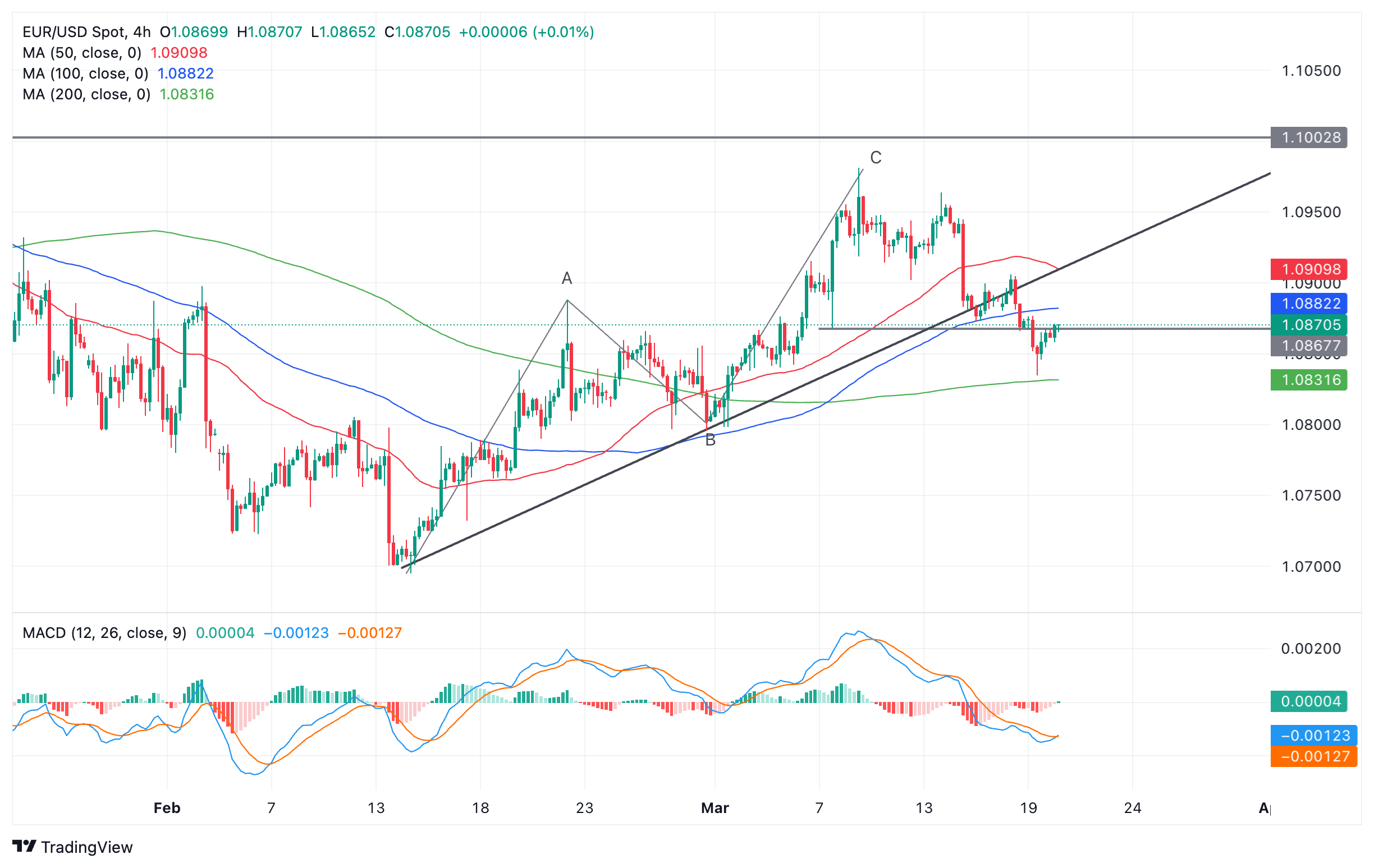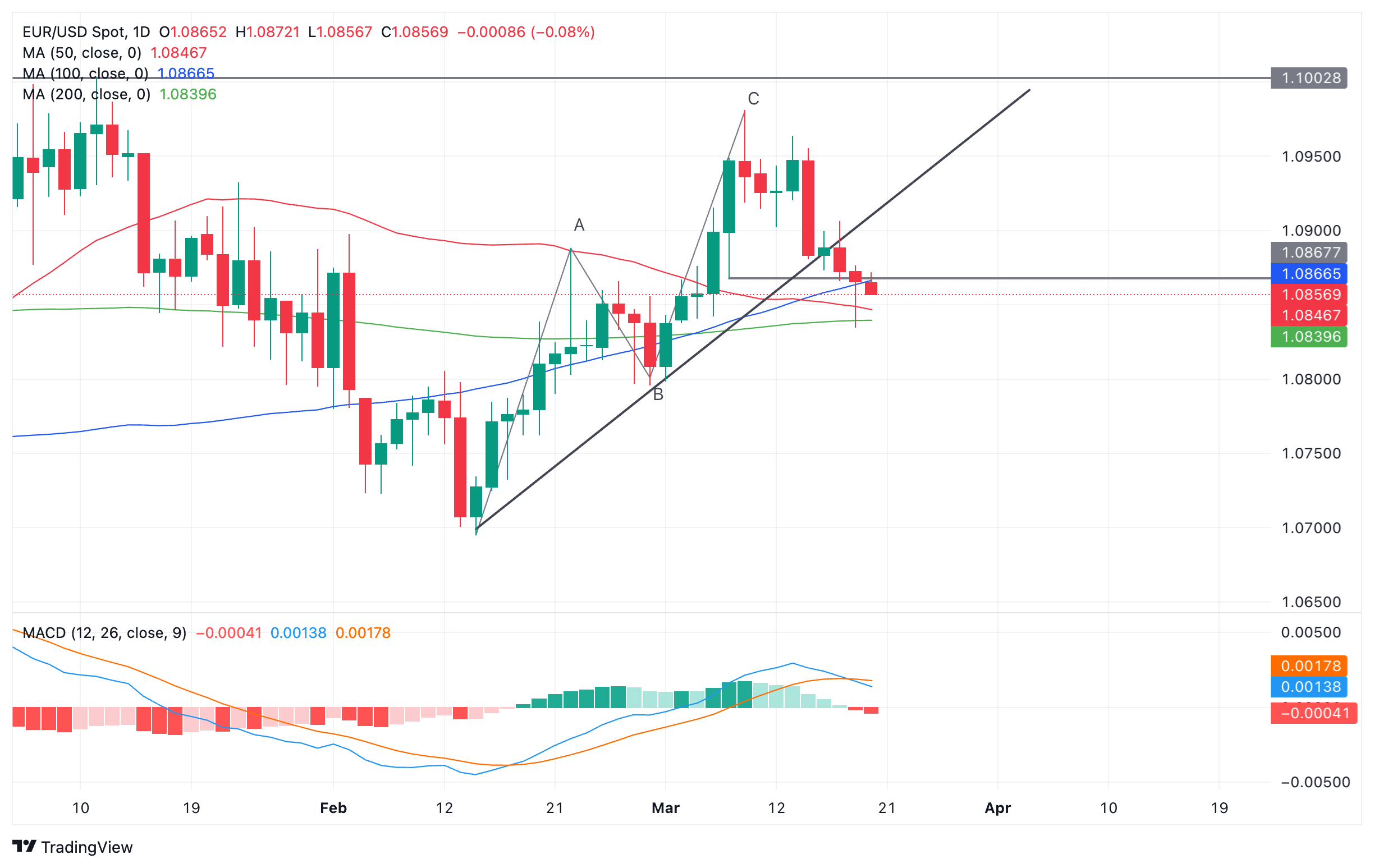- Analytics
- News and Tools
- Market News
- EUR/USD seesaws in range ahead of Fed decision
EUR/USD seesaws in range ahead of Fed decision
- EUR/USD recovers and oscillates in a range in the upper 1.0800s ahead of Wednesday’s Fed meeting.
- Speculation is mounting that the Fed could alter how many interest rate cuts it expects to make in 2024.
- Several ECB rate-setters are scheduled to take the stand at a conference on monetary policy.
EUR/USD seesaws between tepid gains and losses on Wednesday, forming a range in the upper 1.0800s after rebounding from Tuesday’s 1.0830 lows on increased probabilities the Federal Reserve (Fed) will cut interest rates by June.
Interest rates, set by central banks, are a key driver of foreign exchange markets. Lower interest rates tend to depreciate a currency by attracting less foreign capital inflows and vice versa for higher interest rates.
EUR/USD rebounds as June bets pick up
EUR/USD has recovered marginally ahead of the Federal Reserve’s March Federal Open Market Committee (FOMC) meeting on Wednesday, the outcomes of which will be announced at 18:00 GMT. Bets that the Fed will start cutting interest rates – currently at 5.25%-5-50% for the Fed Funds Rate – by June are increasing.
According to the CME FedWatch Tool, which uses Fed Fund Futures to calculate the probability of future changes in the Fed Funds Rate, the probability of the Fed cutting rates by June is 64.0%, and 78.9% by July.
This marks an increase from the 55.1% and 73.7%, respectively, seen on Tuesday. This change in expectations could be responsible for the recovery in EUR/USD, which measures the value of a Euro in US Dollars.
Fed could change forecasts
The Fed is not expected to alter interest rates at its meeting but there is a chance it could revise its quarterly forecasts and accompanying statement. This could change the outlook for interest rates and therefore the US Dollar (USD) valuation.
EUR/USD could see volatility after the Fed meeting. Speculation is mounting that the Federal Reserve will revise its economic forecasts in the Summary of Economic Projections (SEP), and the “dot plot”, which reflects the Board of Governors of the Fed’s consensus of the future path of rates.
In the previous SEP, officials forecast three 25 basis points (0.25%) rate cuts in 2024 but some analysts now think there is a material risk that this could be revised down to two 25 bps cuts to reflect inflationary pressures remaining elevated.
“The summary of economic projections will be updated and contains hawkish risks in our assessment with the committee potentially projecting fewer cuts in 2024,” says David Doyle, head of economics at Macquarie, in a note about the Fed meeting.
ECB speakers set to take the stand
In Europe, a similar debate is going on about when to begin cutting interest rates, with two camps emerging – those who favor waiting until the European Central Bank’s June meeting to decide (the official camp) and a smaller mutineering group who want to keep alive the possibility of an early spring rate cut.
On Tuesday, Vice-President of the European Central Bank (ECB), Luis de Guindos, maintained allegiance with the June camp after he said “we have to wait,” because “services inflation” remains too high.
Wednesday will see a host of ECB talking heads appear in public who could provide further intelligence on which way the ECB is swinging. This may also impact EUR/USD volatility.
The ECB President Christine Lagarde, ECB Chief Economist Philip Lane and ECB Executive Board member Isabel Schnabel are all set to speak at an "ECB and its Watchers" conference today, with Lagarde kicking off at 8.45 GMT, Lane at 9.30 and Schnabel at 13:45.
Later, the President of the Bundesbank, Joachim Nagel, is scheduled to take the podium at a “Future of European Finance" conference at the ASKO Europa-Stiftung Foundation.
Technical Analysis: EUR/USD falls below key level
EUR/USD has penetrated below the level of the 1.0867 swing lows and in doing so probably reversed the direction of the short-term uptrend. Now the odds slightly favor more losses.
Euro versus US Dollar: 4-hour chart
Subject to fundamentals, the price will probably continue to fall to the next key support level at roughly 1.0800 – the lows of wave B of the Measured Move that unfolded in February and early March.
Thursday’s sell-off fell to a low of 1.0835 before recovering and thereby forming a bullish Japanese hammer reversal candlestick pattern on the 4-hour chart. This was followed by a little move higher. Since candlesticks are only short-term patterns, this upside could be at risk of petering out.
The daily chart below is showing the Moving Average Convergence/ Divergence (MACD) momentum indicator crossing over the signal line, giving a bearish sell signal, and adding further evidence to a change of trend.
However, it is also flagging up some key barriers to progress lower in the form of dynamic support from the red 50-day and then the green 200-day Simple Moving Averages (SMA).
Euro versus US Dollar: Daily chart
On Tuesday price penetrated the 50-day SMA situated at 1.0848 but was repulsed by the 200-day SMA at 1.0839. As on the 4-hour chart, the price recovered and formed a hammer candlestick on the daily chart as well.
For confirmation of the hammer’s bullish reversal potential, Wednesday needs to end on a bullish note as a green candlestick. If that is the case, EUR/USD is likely to continue its recovery higher.
Euro FAQs
The Euro is the currency for the 20 European Union countries that belong to the Eurozone. It is the second most heavily traded currency in the world behind the US Dollar. In 2022, it accounted for 31% of all foreign exchange transactions, with an average daily turnover of over $2.2 trillion a day. EUR/USD is the most heavily traded currency pair in the world, accounting for an estimated 30% off all transactions, followed by EUR/JPY (4%), EUR/GBP (3%) and EUR/AUD (2%).
The European Central Bank (ECB) in Frankfurt, Germany, is the reserve bank for the Eurozone. The ECB sets interest rates and manages monetary policy. The ECB’s primary mandate is to maintain price stability, which means either controlling inflation or stimulating growth. Its primary tool is the raising or lowering of interest rates. Relatively high interest rates – or the expectation of higher rates – will usually benefit the Euro and vice versa. The ECB Governing Council makes monetary policy decisions at meetings held eight times a year. Decisions are made by heads of the Eurozone national banks and six permanent members, including the President of the ECB, Christine Lagarde.
Eurozone inflation data, measured by the Harmonized Index of Consumer Prices (HICP), is an important econometric for the Euro. If inflation rises more than expected, especially if above the ECB’s 2% target, it obliges the ECB to raise interest rates to bring it back under control. Relatively high interest rates compared to its counterparts will usually benefit the Euro, as it makes the region more attractive as a place for global investors to park their money.
Data releases gauge the health of the economy and can impact on the Euro. Indicators such as GDP, Manufacturing and Services PMIs, employment, and consumer sentiment surveys can all influence the direction of the single currency. A strong economy is good for the Euro. Not only does it attract more foreign investment but it may encourage the ECB to put up interest rates, which will directly strengthen the Euro. Otherwise, if economic data is weak, the Euro is likely to fall. Economic data for the four largest economies in the euro area (Germany, France, Italy and Spain) are especially significant, as they account for 75% of the Eurozone’s economy.
Another significant data release for the Euro is the Trade Balance. This indicator measures the difference between what a country earns from its exports and what it spends on imports over a given period. If a country produces highly sought after exports then its currency will gain in value purely from the extra demand created from foreign buyers seeking to purchase these goods. Therefore, a positive net Trade Balance strengthens a currency and vice versa for a negative balance.
© 2000-2024. All rights reserved.
This site is managed by Teletrade D.J. LLC 2351 LLC 2022 (Euro House, Richmond Hill Road, Kingstown, VC0100, St. Vincent and the Grenadines).
The information on this website is for informational purposes only and does not constitute any investment advice.
The company does not serve or provide services to customers who are residents of the US, Canada, Iran, The Democratic People's Republic of Korea, Yemen and FATF blacklisted countries.
Making transactions on financial markets with marginal financial instruments opens up wide possibilities and allows investors who are willing to take risks to earn high profits, carrying a potentially high risk of losses at the same time. Therefore you should responsibly approach the issue of choosing the appropriate investment strategy, taking the available resources into account, before starting trading.
Use of the information: full or partial use of materials from this website must always be referenced to TeleTrade as the source of information. Use of the materials on the Internet must be accompanied by a hyperlink to teletrade.org. Automatic import of materials and information from this website is prohibited.
Please contact our PR department if you have any questions or need assistance at pr@teletrade.global.

















